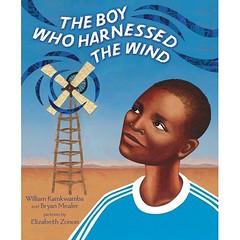The Boy Who Harnessed The Wind
Young Reader’s Edition
Written by William Kamkwamba and Bryan Mealer
Illustrated by Elizabeth Zunon
Publisher: Dial
ISBN: 978-0803735118
Summary/Back cover:
When fourteen-year-old William Kamkwamba's Malawi village was hit by a drought, everyone's crops began to fail. Without enough money for food, let alone school, William spent his days in the library . . . and figured out how to bring electricity to his village. Persevering against the odds, William built a functioning windmill out of junkyard scraps, and thus became the local hero who harnessed the wind.
Lyrically told and gloriously illustrated, this story will inspire many as it shows how - even in the worst of times - a great idea and a lot of hard work can still rock the world.
Review:
Themes/Discussion Topics: Self-empowerment, Ingenuity, Africa, English-Language Learning, Hunger, Famine, Education, Role of Libraries, Recycling
Inventor William Kamkwamba and journalist Bryan Mealer collaborate with illustrator Elizabeth Zunon to masterfully share with the young reader the story of William’s life in drought-ravaged Malawi and his ingenuity that inspired him to build a windmill that would illuminate his life and the lives of those around him.
William was forced to drop out of school after a severe drought and famine struck Malawi. Instead of abandoning his education entirely, William started going to the local library in an effort to continue his education. He used the library books to teach himself how to build a windmill and dictionaries to learn English one word at a time.
In order to build his windmill, William collected spare bicycle parts, a tractor fan, plastic pipes and other useful items that others had discarded as trash. Although the people in his village thought that he was crazy, he persisted and ultimately succeeded in building a windmill that provided enough electricity to power several light bulbs and two radios as well as provide water for his family.
Kamkwamba and Mealer tell the story in a compelling manner that captures and maintains the young readers attention throughout the book. Issues such as poverty, famine and starvation are contrasted with concepts such as imagination, self-empowerment and education in way that a child can understand and appreciate without feeling overwhelmed. Zunon’s intensely beautiful illustrations comprised of oil-painted backgrounds with carefully cut pieces of fabric, paper and old photographs create vibrant and textured collages that compliment the text and subtly mirror William’s story by assembling old pieces of various materials to create a new whole that at times seem to have a story of their own to tell.
Although the story told in the book culminates with the construction of the windmill, William’s story does not end with that amazing accomplishment. An update on the final pages about William’s life after building the windmill is provided so that the young reader can be inspired by how William’s hard work and determination paid off and continues to do so for William.
I enjoyed reading The Boy Who Harnessed the Wind with my children and more importantly they benefitted from hearing William’s story. The book provided us with an opportunity to discuss important issues like hunger, access to education and the transformative power of science and the imagination. As a parent, I remain appreciative of this heart-warming and thought-provoking book that inspired my children to ask “[c]ould we build a windmill?”
Review written by Black Kids Read

No comments:
Post a Comment